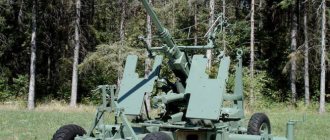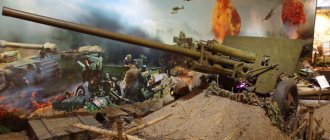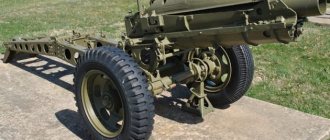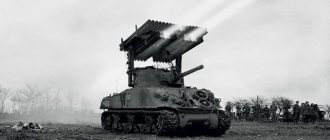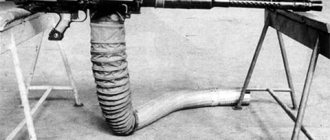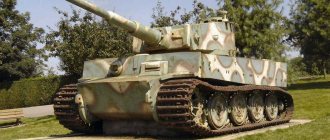Anti-aircraft artillery of the ground forces
Anti-aircraft artillery of the ground forces
By the beginning of World War II, the only divisional air defense units were motorized companies, each of which had 12 20-mm Flak 30 anti-aircraft guns. Such companies were attached to most tank divisions (except the 2nd and 5th), all four light divisions , as well as some infantry divisions of the 1st wave. During the French campaign, Wehrmacht divisions were left with virtually no standard anti-aircraft weapons. Only in July 1940, i.e., after the end of the campaign in the West, the first anti-aircraft division in the ground forces appeared as part of the 22nd Airborne Division, each of the two fire batteries of which had a dozen 37-mm cannons on half-track tractors . In the 5th Light Division operating in North Africa, a motorized three-battery division with 20-mm cannons was formed (and in addition, it was given a Luftwaffe anti-aircraft division with three 88-mm batteries and two 20-mm cannons). But most of the other divisions at the beginning of Operation Barbarossa had only one 20-mm anti-aircraft gun assigned to a company.
In 1942, a self-propelled anti-aircraft company, armed with anti-aircraft guns mounted on the chassis of half-track tractors, was introduced into the staff of tank divisions. Thanks to this, anti-aircraft units were able to accompany tank battalions. In addition, the reaction time of an anti-aircraft self-propelled gun (ZSU) to an emerging threat from the air while on the march is significantly lower than that of a towed gun. Anti-aircraft companies in tank divisions had eight ZSUs - two 37-mm Flak 36 guns on the chassis of 5-ton Sd.Kfz tractors. 5/1 and six 20-mm Flak 30 cannons mounted on one-ton Sd.Kfz. 10/4. In other divisions, anti-aircraft weapons were introduced extremely slowly. Only in 1943 did regular air defense systems appear in four motorized divisions - the 3rd,
16th, 29th and 60th. These divisions were destroyed in encirclement at Stalingrad, and their re-establishment had, in addition to purely military, propaganda significance. Therefore, special attention was paid to their recruitment and armament. Each of the two motorized regiments in these divisions received one company with 12 20-mm anti-aircraft guns, and in one regiment such a company was self-propelled, and in the other it was mechanized. But that’s not all - a fourth, anti-aircraft division was added to the artillery regiments of these divisions. Two batteries of this division were heavy and had four 88-mm Flak 18/36/37 anti-aircraft guns and three 20-mm Flak 38 cannons. The third - light - battery had a dozen 20-mm cannons. Thus, the division had fifty anti-aircraft guns - eight 88 mm and 42 20 mm. The remaining motorized (panzergrenadier) divisions remained without regular air defense systems until the summer of 1944.
In 1943, anti-aircraft divisions were also introduced into tank divisions. They were stronger in composition than in the “Stalingrad” motorized divisions. In addition to two heavy and light batteries, they also received a fourth battery with nine 37 mm anti-aircraft guns, as well as a self-propelled platoon armed with two quadruple 20 mm Flakvierling 38 cannons on the chassis of 8-ton Sd.Kfz half-track tractors. 7/1. The states also envisaged the introduction of a company with 12 20-mm anti-aircraft guns into each of the two panzergrenadier regiments, but in reality the tank divisions of these companies never received them.
Thus, only a few Wehrmacht divisions that made up its shock fist had fairly strong air defense systems. In all other divisions, since 1943, only a company of light anti-aircraft guns was introduced.
Airfield divisions occupied a special place. Created as part of the Luftwaffe, they received unusually strong air defense systems. Such divisions received a three-battery anti-aircraft division consisting of one heavy battery (four 88 mm and three 20 mm guns) and two light batteries (12 20 mm guns each). In addition, each of the division's four infantry battalions had four 20 mm Flak 38 cannons in its heavy weapons company - these guns were also intended for firing at ground targets. Thus, the division, corresponding in its combat capabilities to the brigade, consisted of four 88-mm anti-aircraft guns and as many as 43 20-mm anti-aircraft guns. The parachute divisions also had very strong air defense systems. Each of them received an anti-aircraft division of five batteries, which included three heavy batteries (four 88-mm and three 20-mm anti-aircraft guns) and two light batteries (12 20-mm guns each) - in total, 12 88-mm and 30 20 -mm anti-aircraft guns.
Much stronger anti-aircraft weapons were available to the panzergrenadier and panzer divisions of the Waffen SS. Their anti-aircraft divisions had not two, but three heavy batteries, and the battery of 37-mm guns was self-propelled - on the chassis of Sd.Kfz tractors. 6/2 or Sd.Kfz. 7/2. Moreover, the division even included a searchlight battery with four searchlights with a diameter of 60 cm - the smallest anti-aircraft searchlights produced in Germany. The panzergrenadier regiments of these divisions each had an anti-aircraft company with 12 20-mm anti-aircraft guns on the Sd.Kfz chassis. 10/4. Four of the same installations were in the division headquarters' security company, and the artillery regiment's headquarters battery had four 20-mm quad SPAAGs on the Sd.Kfz chassis. 7/1.
The growing threat from the air forced us to increasingly strengthen the air defense of divisions, primarily mobile ones. In August 1944, a new staff of tank and panzergrenadier divisions was introduced, which provided for the saturation of almost all parts of these divisions with anti-aircraft weapons. The anti-aircraft division of the artillery regiment in the tank and panzergrenadier divisions was now similar in composition. It had two heavy batteries of six 88 mm and three 20 mm anti-aircraft guns each. The third battery could have either nine 37-mm mechanized anti-aircraft guns and three 20-mm quad Sd.Kfz self-propelled guns. 7/1, or 12 towed 20-mm guns. Also, a searchlight battery (four searchlights) was introduced into the division, following the model of the Waffen SS divisions. The headquarters batteries of the artillery divisions received three 20-mm anti-aircraft guns, and a company with six of the same guns was introduced into each Panzergreder battalion. Finally, the tank regiment had eight 37-mm Möbelwagen self-propelled guns in its anti-aircraft company, and at the headquarters of each tank battalion there were three 20-mm quadruple Virbelwind self-propelled guns. Both of the latter types of ZSU were built on the chassis of the Pz.Kpfw tank. IV. At the beginning of 1945, a subsequent change in the staff of tank and panzergrenadier divisions took place. Regarding air defense systems, the only innovation was the introduction of the Sd.Kfz self-propelled gun. 251/21 - 20-mm triple installations on the chassis of half-track armored personnel carriers. Each division was to receive 12 of these ZSUs, of which three were included in the anti-aircraft company of the tank regiment, and three more in each of the three companies of the panzergrenadier battalion on the armored personnel carrier. The anti-aircraft company of a tank regiment could be equipped with ZSU in one of three options: eight Virbelwind or eight 37-mm Ostwind ZSU, or in a mixed version - four units of each type. Additionally, the company was provided with three quadruple 20-mm anti-aircraft guns on the chassis of Sd.Kfz half-track tractors. 7/1.
The Wehrmacht entered World War II with virtually no air defense systems in its divisions. At first there was no particular need for them, since the Luftwaffe ensured complete air supremacy. But when the threat from the air became quite tangible, it turned out that there were no resources to provide each division with anti-aircraft weapons. In such a situation, a natural and completely justified choice was made - strong air defense units were introduced into the shock divisions, tank and panzergrenadier. The remaining divisions were forced to make do with very modest, even symbolic means - at best, a dozen small-caliber anti-aircraft guns.
The Wehrmacht ground forces had their own anti-aircraft artillery units of the RGK, independent of the Luftwaffe - although very few in number. In relation to these units, the ground forces used the terms “battalion” and “company” instead of “division” and “battery,” but we will stick to the latter, as they are more familiar to artillery. So, by September 1st
In 1939, the ground forces had 47 separate anti-aircraft artillery batteries. In June 1941 there were already 10 divisions and 29 separate batteries, and a year later there were 18 divisions. By the end of 1942, the composition of the army air defense artillery was reduced to 13 divisions and nine batteries, and they were armed with only the lightest, 20-mm anti-aircraft guns. A plus can be considered the fact that ten divisions were armed with self-propelled guns built on the basis of half-track tractors. Each self-propelled division had four batteries. The batteries themselves were of two types: either 12 single-barrel anti-aircraft guns on Sd.Kfz tractors. 10/4 (in four divisions), or eight of the same guns and two quadruple anti-aircraft guns on the Sd.Kfz chassis. 7/2 (in six divisions). The remaining three divisions were composed of three batteries and were armed with towed guns. There were also two options for organizing batteries: 12 single-barreled anti-aircraft guns (in two divisions) or eight single-barrel and two quadruple (in one). The individual batteries were very weak in composition: one motorized one had four 20-mm single-barreled guns, and eight stationary ones had only a pair of such guns each. Subsequently, despite the increasing threat from the air, the number of army air defense units was reduced due to the redistribution of funds to the division level. In July 1943, the ground forces had only six motorized anti-aircraft artillery divisions. Each of them had three batteries: two with 12 20-mm cannons, and the third with nine 37-mm anti-aircraft guns or eight 20-mm four-barreled guns.
The Waffen SS also had their own anti-aircraft units under the corps. In particular, the tank corps and the 5th Mountain Corps each had an anti-aircraft division. Typically, such a division had three heavy batteries (four 88-mm and three 20-mm guns) and one light battery (nine 37-mm guns). Sometimes the Waffen SS corps, instead of a division, included only one motorized battery with nine 37-mm cannons.
By May 1944, the Wehrmacht ground forces had the following number of anti-aircraft weapons in the divisions and units of the RGK: 6355 single-barreled and 925 quadruple 20-mm guns, 775 37-mm guns and 574 88-mm guns. These numbers, which seem quite large, pale when compared with the number of Luftwaffe anti-aircraft weapons. So, the latter had at that time more than 400 128-mm anti-aircraft guns, about 2000 105-mm, about 10,000 88-mm anti-aircraft guns, approximately 3,500 37-mm and 20,000 - 20-mm - and this is not counting the thousands of captured guns !
It is characteristic that the vast majority of anti-aircraft artillery units of the Wehrmacht RGK had small-caliber anti-aircraft guns, while 88-mm guns were available in divisions. This trend continued and even intensified in the last months of the war. At the end of 1944, the formation of ten partially motorized anti-aircraft artillery brigades began within the ground forces. These brigades were not intended for air defense of front-line units, but, first of all, to cover supply lines - according to calculations, it was assumed that one brigade would be able to cover a road 150 km long. Since at that time the main danger to the ground forces was posed by low-flying attack aircraft and fighter-bombers, the brigades were armed exclusively with small-caliber, 20-mm anti-aircraft guns, supplemented by a small number of 37-mm guns. According to the state, the brigade consisted of two divisions of four batteries. Each division included five batteries of 24 installations. Four of them were armed with new 20-mm triple anti-aircraft guns (created using MG-151/20 aircraft guns), the fifth had 12 20-mm quad mounts and the same number of 37-mm anti-aircraft guns. Thus, the brigade had 240 anti-aircraft guns - 216 20 mm and only 24 37 mm. Like other artillery units at the end of the war, anti-aircraft artillery brigades received a significant number of Panzerfausts - according to the staff, 500 pieces. The number of brigade personnel was 1917 people. The brigade had 136 vehicles, that is, it was 33% motorized.
According to the plans of the ground forces command, the formation of the first four anti-aircraft artillery brigades was supposed to be completed by January 10, 1945, and the remaining six to be formed during February. It was not possible to establish whether these plans were implemented in full. In any case, in March 1945 there were only eight light anti-aircraft artillery brigades - from the 501st to the 508th. Since there were not enough new 20-mm built installations, the brigades received conventional single-barreled guns instead of some of these guns, which negatively affected the density of fire, and therefore the effectiveness of covering objects.
Machine guns
The 7.92 mm MG-34 machine gun, and later the MG-42 main universal machine gun, were the lightest weapons that could be effectively used in an anti-aircraft role. The MG-34, erroneously known among the Western Allies as the "Schrandau", was the standard German general-arms machine gun in 1939. With a muzzle velocity of 755 m/s and an effective range on the ground of 2000 m, in the anti-aircraft version it was reduced to approximately 1000 m. The rate of fire of the machine gun was 900 rounds/min, the cartridges were supplied from a 75-round round magazine or a 50-round separate belt.
The MG-42 machine gun replaced the MG-34 during the war. It was cheaper to produce by using stamped parts and spot welding to speed up production. The machine gun had the same bullet speed and firing range, but the rate of fire was increased to 1550 rounds/min.
The rate of fire is very important when firing at air targets, but the MG-34 turned out to be more effective when mounted in tandem on the Zvi-linglafet mod. 36 (Zwillingslaffete 36). The MG Doppelwagen 36 installation with twin MG-34 machine guns on horse or mechanical traction, adapted for operation by one person, was part of the equipment of the German army in 1939-1940, but was often installed on cars or railway cars.
The most common means of defense against low-flying enemy aircraft is machine guns. The MG-34 general purpose machine gun is the standard secondary weapon on most German aircraft.
The Wehrmacht did not use heavy machine guns, but to enhance air defense they adopted the 15-mm Maschinengewehr 151/15 machine gun. The machine gun was originally created for the Luftwaffe and was installed on the Me-109 or Fw-190 fighters; it proved useful as a heavy weapon for fighters. The production of these machine guns was aimed at strengthening air defense in the summer of 1944. The machine gun was mounted on a half-track armored personnel carrier SdKfz-251/21, which is significant, since the Mauser installation was driven by electric current and required a constant voltage of 22-29 V. The ammunition load of each installation was 3000 cartridges ready for use.
Not just air
The straight trajectory and high velocity of the Flac light cannon's projectiles made them an ideal weapon for close-in support, and in the early years of the war they were used more against ground targets. Fighters and anti-aircraft guns made the front line a deadly place for slow French and British light bombers attacking armored columns and transport hubs during the German invasion of France in 1940.
Beginning in 1943, when the Luftwaffe no longer had superiority over German skies, huge quantities of tracer shells were fired by Flack gun units to deter fighter-bombers from "looting." Light Flacs placed on building roofs and turrets posed a deadly threat to low-flying fighters and light bombers, as the cannons could fire almost horizontally at approaching aircraft.
Self-propelled guns Flak
The SdKfz 7 half-track vehicle was used as a chassis for the 20-mm Flak installations Mittler Zugkrafwagen 8(t) mit 2 sm Flakvierling 38 or Selbstfahrlafette 2 sm Flakvierling 38. Later modifications had enhanced armor protection for the driver and crew.
The Pz IV chassis was used for two very effective self-propelled guns for the Flakfirling 38. Installation “Flak Panzer IV” (2 cm Flakvierling 38) auf Fgst PzKpfw IV Mobelwagen, nicknamed “Wagon Inventory” for its hinged side shields in the form of 10-mm armor plates, which fold down when the installation is transferred to the firing position.
Mobility of Flak installations
"Flac 30" weighed 483 kg in combat position. It could fire high-explosive or armor-piercing shells. The maximum vertical range is 2100 m, and the horizontal range is 2700 m. The practical rate of fire was 120 rounds/min. “Flac 38” is an improved modification, lighter by 80 kg and with a doubled rate of fire.
Light Flak cannons were installed on various wheeled and half-tracked vehicles, including the SdKfz-251 and SdKfz-10. Leichte Flakpanzer 38(t) 1943 - the first fully tracked vehicle used for anti-aircraft guns, and consisted of a Flak 38 cannon on a modified Pz 38(t) tank chassis.
The Flakvierling 38 was developed for the Kriegsmarine, it included four Flak 38 cannons on one carriage. The installation had three seats: one for the shooter, who fired using two pedal triggers, and two for the loaders. The installation had a triangular base, which was leveled with jacks. It was widely used on self-propelled and ground-based installations in the army and aviation.
